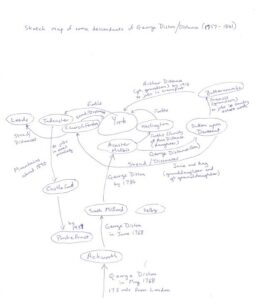Our transcription volunteer, Barbara, has traced the childhood of her 4x great-grandfather, George Diston (later, Distance), using Coram’s Founding Hospital Archive.
My Grandmother told me her family were descended from a Foundling boy. The family story had somehow become confused with Oscar Wilde’s play The Importance of Being Ernest as she claimed the family name of Distance was because he had been found at a railway station, like Ernest in the play. That was definitely inaccurate because my ancestor’s time at the Foundling Hospital was long before the railways.
George Diston was the name given to him by the Foundling Hospital when he was handed in as a baby, unchristened and wrapped in a plain head cloth. The Foundling Hospital Archive shows that he was admitted on 28 June 1757 and given the number 4935. A note on his billet sheet says ‘Hillinton, Middlesex’, which I think might be a misspelling of Hillingdon, indicating where he came from. George then spent the next nine years with a nurse, Martha Tufte of Hadley, Hertfordshire (now in the London Borough of Barnet).
- A_FH_A_09_002_002_142 George Diston in the General Register. Click to enlarge.
- A_FH_A_03_005_006_172 George Diston in the Sub-Committee Minutes. Click to enlarge.
Smallpox was a common and terrible illness in the 18th century, and the Foundling Hospital tried to inoculate the children against it. But cases still occurred, and the records were marked S.P. for children who did catch the disease. This happened to George, and it might be why he spent a long time with Martha. He returned to the Foundling Hospital on 12 April 1766, just before his ninth birthday, but he had missed out on much of the education the Hospital provided.
In May 1768, George was sent to the Hospital’s satellite site at Ackworth, just north of Barnsley, South Yorkshire. The Ackworth registers have suffered over the years, but I could still find that on 13 July 1768, aged 10, George was apprenticed to Will Rhodes, a farmer at South Milford near Selby. This was only 16 miles from Acaster Malbis (close to York) where George lived out his days as an agricultural labourer, a common occupation in this period.
On 12 May 1784, George Diston married Ann Stubbs at St Nicholas Church, Askam Bryan near York. He marked the Banns record with a cross; so it would seem that he could not spell his surname. The point when the surname changed can be found at the baptism of his eldest daughter, Hannah Distance, in 1784. George and Ann had nine children, and (so far) I’ve found 26 grandchildren and 73 great grandchildren. The family were christened into the Anglican faith, which has good parish records.
George and Ann lost two children to a fever in 1800. William died age 17 and Isabella died age 11. This must have had a very great effect as their parents put a headstone in the churchyard at Holy Trinity, Acaster Malbis, which was unusual for a working-class family at the start of the 19th century.
Two of their remaining seven children had very large families: their son George, from whom most Distances today are descended, and their daughter Ann, who married Thomas Forth. If you find a British Distance after 1785 in family research, they will be descendants of George, the Foundling boy. My sketched map shows where most of his descendants settled. Very few left Yorkshire – we do think it’s ‘God’s own country’!
- Barbara’s sketched map. Click to enlarge.
- A_FH_A_12_003_001_187 George Diston in the Apprenticeship Register. Click to enlarge.
George and Ann both died from ‘decay of nature’ (old age is what we would say now). He died on 19 June 1841, just a few days short of 84 years old, and Ann died 2 April 1842.
As a volunteer on Coram’s Voices Through Time programme, I transcribed the register of children placed with the Foundling Hospital by London parish churches in the 18th century. From these, it is clear that many came into the Hospital’s care because of family poverty. I am now transcribing a badly water-damaged register for the Ackworth Foundling Hospital, in the hopes of bringing to light more stories about the Yorkshire-based Foundlings.
Bibliography
Billet Book: A/FH/A/09/001/061/029
General Register: A/FH/A/09/002/002/142
Nursery Book: A/FH/A/10/003/005/040
Ackworth Register: A/FH/Q/01/064
Sub-Committee Minutes: A/FH/A/03/005/006/122 and /172
Apprenticeship Register: A/FH/A/12/003/001/187




